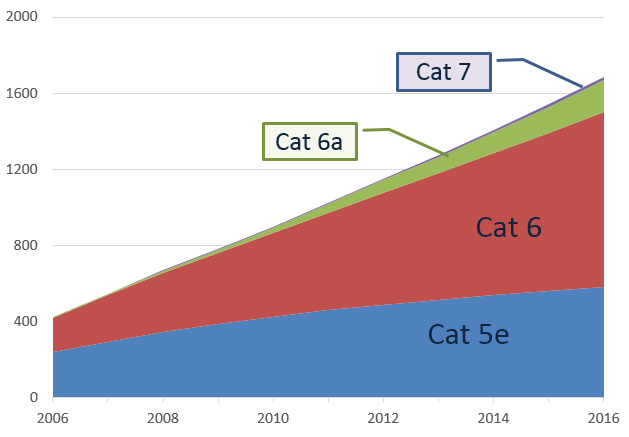New 802.3bz Ethernet standard: up to 5 Gbps unshielded twisted pair

RJ-45 connector. Photo: Gutza, Mike1024
On September 27, 2016, the Ethernet Alliance consortium approved the IEEE 802.3bz specification, which lights the green light for the widespread adoption of two new standards 2.5GBASE-T and 5GBASE-T.
The introduction of new standards will dramatically increase the speed of data transmission over Ethernet networks. According to the previous standard 1000BASE-T (IEEE 802.3ab), the maximum theoretical speed limit is 1 Gbit / s, and according to the new standards it is 2.5 Gbit / s and 5 Gbit / s, respectively. A noticeable step forward. Most importantly, such acceleration is achievable on the old cable infrastructure, that is, on the previous copper cables of categories 5e and 6 (Cat5e and Cat6) with the same length up to 100 meters.
Over the past 15 years, approximately 1.7 billion Ethernet outlets have been installed worldwide, the vast majority of which are for conventional Cat5e and Cat6 copper cables. According to analysts, approximately 70 billion meters of twisted pair have been laid in the world. This is enough to rewind the Earth at the equator 1700 times. Well, or stretch the Ethernet to Mars, when it is at a minimum distance from Earth.
')

The number of installed Ethernet sockets (in millions) by cable type. Data source: BSRIA Dec. 2014
Thus, organizations can breathe easy - kilometers of cables do not have to be replaced and re-laid when moving to a new standard.
Other Ethernet options have a higher bandwidth of 10 Gb / s. But as can be seen from the diagram above, in ten years they have not received wide distribution. Perhaps because the introduction of these standards requires laying new cables or reducing the length when using old cables. The developers hope that IEEE 802.3bz will not repeat the fate of its predecessors.
Of course, not all companies, and especially home users, urgently need to move to a new standard. The increase in speed in the "LAN" does not affect the speed of the Internet. But the standards 2.5GBASE-T and 5GBASE-T provide for the future a large supply of speed for old cables. This is very good news.
The IEEE 802.3bz specifications have just been approved and published. It will probably take one or two years before network cards, motherboards, laptops, and computers with 2.5GBASE-T and 5GBASE-T support go on sale.
One of the main initiators of the adoption of new standards was Cisco. It already releases a number of IEEE 802.3bz-enabled devices (the company calls its own version of the NBASE-T standard): these are the Aironet 3800 and Meraki MR53 access points, Catalyst 3560-CX, Catalyst 3650, Catalyst 3850 and Catalyst 4500 switches.
Interestingly, the preparation of new specifications was completed in a fairly short time. From the moment of the beginning of work to the publication of the final version of the specifications, it took only a half year.
The standard includes MAC parameter specifications and PHY physical layer specifications. At the physical level, the IEEE 802.3bz transmission technology is based on 10GBASE-T, but the signaling speed is specially reduced by 2-4 times. Accordingly, the bandwidth is reduced, which reduces the quality requirements of the cable. Therefore, the 2.5GBASE-T and 5GBASE-T channels with a length of up to 100 meters can be laid on the usual unshielded twisted pair Cat5e and Cat6, respectively.
Category 5e and 6 cables consist of four twisted pairs. They are terminated by modular RJ-45 connectors or on patch panels. Most cables are unshielded. Each of the four pairs of cable has its own twisting step in order to minimize interferences between the pairs. For category 5e cables, they tightened the requirements and introduced new crosstalk specifications. In particular, limits are introduced on the total reduced transient attenuation at the near end, the transitional attenuation at the far end, the total reduced transient attenuation at the far end, and the delay difference.
Category 6 cable is backward compatible with category 5, 5e and 3 cables, but has more stringent specifications for crosstalk and system noise, and the bandwidth is increased from 100 MHz to 250 MHz.
As usual, the official IEEE specifications are sold for little money: a PDF file costs $ 137 (elsewhere you can find it cheaper).
Source: https://habr.com/ru/post/372713/
All Articles